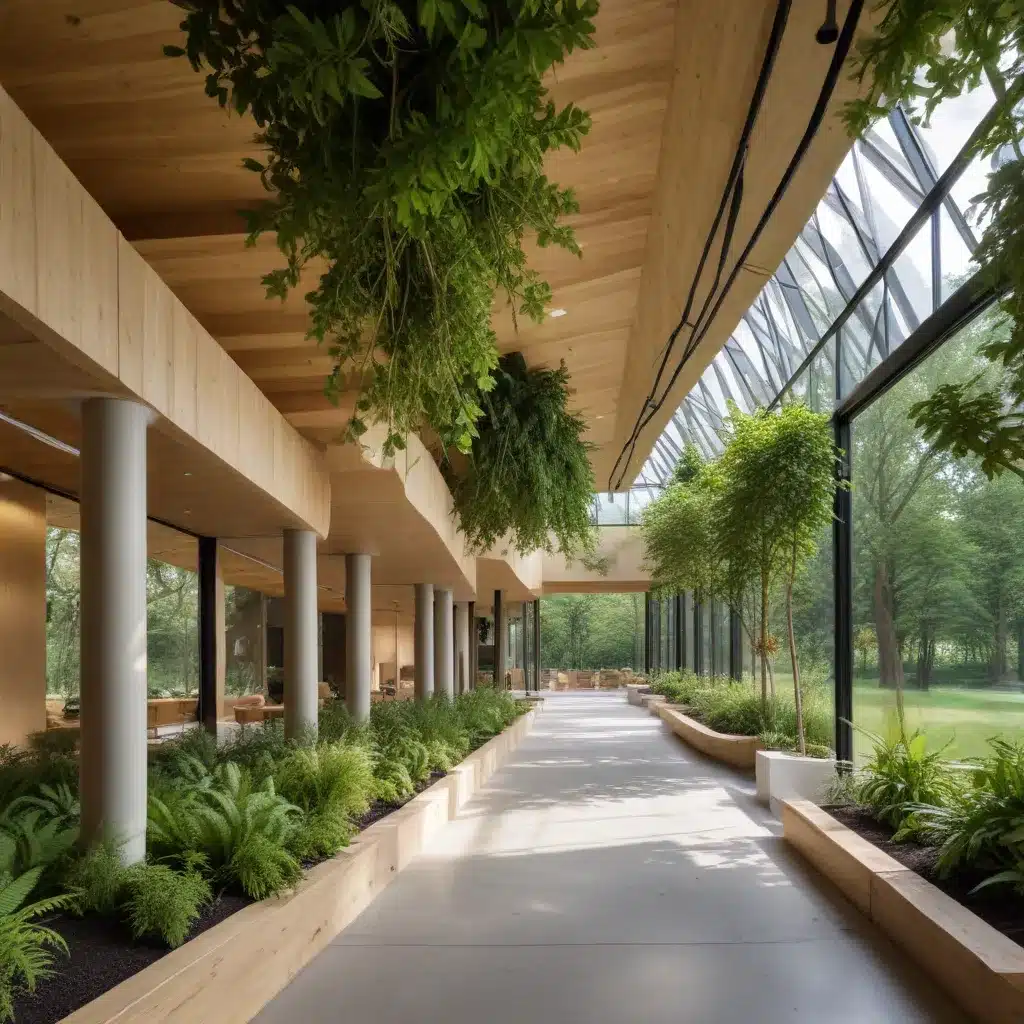
Biophilic design is an architectural and interior design approach that draws inspiration from nature, integrating natural elements, materials, and forms into the built environment. This holistic design philosophy seeks to foster a deep connection between humans and the natural world, promoting physical and mental wellbeing, environmental sustainability, and a heightened sense of place.
Principles of Biophilic Design
At the core of biophilic design are three interconnected principles that guide the integration of nature into the built environment:
Connections with Natural Systems
This principle focuses on creating direct experiences of nature, such as incorporating water features, living greenery, daylight, and natural ventilation. By bringing these elements into interior and exterior spaces, biophilic design aims to strengthen the user’s tangible connection to the natural world.
Sensory Engagement with Nature
Biophilic design also emphasizes the importance of engaging multiple senses through indirect experiences of nature. This can involve the use of natural materials, textures, colors, sounds, and scents that evoke a connection to the natural environment, even in the absence of direct natural elements.
Spatial Patterns of Nature
The third principle of biophilic design is the incorporation of spatial configurations and geometries that mimic the patterns and forms found in nature. This can include the use of fractal-like structures, curvilinear shapes, and hierarchical arrangements that resonate with the human psyche’s innate affinity for natural environments.
Benefits of Biophilic Design
The integration of these principles into the built environment yields a wide range of benefits for both individuals and the broader ecosystem.
Improved Human Health and Wellbeing
Numerous studies have demonstrated that exposure to natural elements and biophilic design features can reduce stress, enhance cognitive function, and improve overall mental and physical health. By fostering a sense of connection to nature, biophilic design has the power to positively impact the wellbeing of occupants.
Enhanced Productivity and Creativity
Biophilic design has also been shown to boost productivity, focus, and creative thinking in a variety of settings, from offices to educational institutions. The presence of natural elements and patterns can stimulate the mind and inspire innovation.
Reduced Environmental Impact
Embracing biophilic design principles can also contribute to environmental sustainability by incorporating energy-efficient strategies, promoting biodiversity, and using eco-friendly materials. This holistic approach helps mitigate the negative impacts of the built environment on the natural world.
Integrating Nature into Built Environments
Architects and designers have developed a diverse range of architectural approaches and interior design strategies to bring the natural world into the built environment, catering to various scales and contexts.
Architectural Approaches
Biomorphic Forms and Patterns: Incorporating organic shapes, textures, and patterns that evoke natural elements, such as curving rooflines, undulating facades, and fractalized surfaces.
Naturalistic Landscaping and Water Features: Integrating lush greenery, water bodies, and other natural elements into the exterior and surrounding landscapes of buildings.
Daylighting and Natural Ventilation: Strategically designing building envelopes and floor plans to maximize the use of natural light and airflow, reducing the reliance on artificial lighting and mechanical systems.
Interior Design Strategies
Incorporating Natural Materials: Using wood, stone, bamboo, and other natural materials that connect occupants to the inherent beauty and tactile qualities of the natural world.
Integrating Greenery and Living Walls: Incorporating indoor plants, vertical gardens, and living walls that improve air quality, provide visual interest, and foster a sense of nature within the built environment.
Connecting Indoors to Outdoor Spaces: Creating seamless transitions between interior and exterior spaces, such as through the use of large windows, sliding doors, and biophilic courtyards or terraces.
Biophilic Design Applications
The principles of biophilic design can be applied across a wide range of building types and scales, from commercial spaces to residential environments.
Commercial Spaces
Office Environments: Biophilic design strategies, such as incorporating natural light, greenery, and natural materials, have been shown to enhance employee wellbeing, productivity, and creativity in office settings.
Retail and Hospitality Settings: Biophilic design elements can create engaging, memorable, and restorative experiences for customers and guests, contributing to increased dwell time, loyalty, and overall satisfaction.
Residential Spaces
Single-Family Homes: Integrating biophilic design principles into private residences can foster a deeper connection to nature and improve the overall quality of life for homeowners and their families.
Multi-Unit Dwellings: Biophilic design approaches, such as shared green spaces and access to natural light, can also enhance the livability and sustainability of high-density residential developments.
Challenges and Considerations
While the benefits of biophilic design are well-documented, there are also some challenges and considerations that must be addressed in its implementation.
Design Constraints
Urban Density and Limited Space: In densely populated urban areas, where land and building footprints are constrained, integrating substantial natural elements can pose a significant design challenge.
Maintenance and Life Cycle Costs: Incorporating living, natural components into the built environment, such as green walls and water features, may require ongoing maintenance and higher upfront costs compared to traditional design approaches.
Sustainability and Resilience
Energy Efficiency: Biophilic design strategies, such as natural ventilation and daylighting, can contribute to improved energy efficiency and reduced environmental impact. However, careful integration with other building systems is crucial to maximize these benefits.
Climate Adaptation: As the impacts of climate change become more pronounced, biophilic design can play a crucial role in enhancing the resilience of built environments, through the use of nature-based solutions and passive design strategies.
By thoughtfully addressing these challenges and considerations, architects, designers, and developers can unlock the full potential of biophilic design, creating built environments that not only captivate the senses but also promote human wellbeing and environmental sustainability.
To learn more about integrating biophilic design principles into your next project, visit TriCounty Tree Care for expert guidance and insights on leveraging nature in the built environment.


